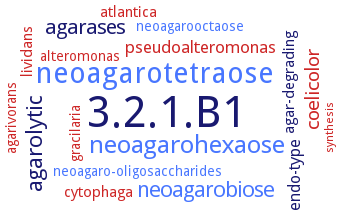3.2.1.B1: extracellular agarase
This is an abbreviated version!
For detailed information about extracellular agarase, go to the full flat file.

Word Map on EC 3.2.1.B1 
-
3.2.1.B1
-
neoagarotetraose
-
neoagarohexaose
-
agarolytic
-
neoagarobiose
-
agarases
-
coelicolor
-
pseudoalteromonas
-
endo-type
-
lividans
-
agar-degrading
-
atlantica
-
cytophaga
-
neoagaro-oligosaccharides
-
gracilaria
-
agarivorans
-
neoagarooctaose
-
alteromonas
-
synthesis
- 3.2.1.B1
- neoagarotetraose
- neoagarohexaose
-
agarolytic
- neoagarobiose
- agarases
- coelicolor
- pseudoalteromonas
-
endo-type
- lividans
-
agar-degrading
- atlantica
- cytophaga
- neoagaro-oligosaccharides
- gracilaria
- agarivorans
- neoagarooctaose
- alteromonas
- synthesis
Reaction
hydrolysis of 1,3-beta-D-galactosidic linkages in agarose, giving the octamer as the predominant product =
Synonyms
Aga21, AgaA, AgaA7, AgaB, AgaB1, AgaC, AgaG1, agaM1, agarase AG-b, agarase-a, agarase-b, beta-agarase, beta-agarase AgaB, endo-acting beta-agarase, endo-type beta-agarase, exo-beta-agarase, extracellular beta-agarase, NifU, YM01-3
ECTree
Advanced search results
Temperature Stability
Temperature Stability on EC 3.2.1.B1 - extracellular agarase
Please wait a moment until all data is loaded. This message will disappear when all data is loaded.
10 - 40
10 - 50
-
up to 80% thermostability of the enzyme is retained at 10°C and 30 °C for 180 min. When the temperature is increased to 50°C for 30 min, the enzyme relative activity is decreased to 10-20%. Nevertheless, the enzyme is fairly stable (almost 70% relative activity) at 40°C for 30 min
20 - 50
-
isoform garase-a is stable at 30°C, while agarase-b is stable at 50°C. Agarase-a shows residual activity remaining above 70% after 60 min at 2030°C. After incubation at 40°C for 60 min, the remaining activity decreases to 28%. Agarase-b shows more than 75% of the maximal activity at 50°C
20 - 60
-
the enzyme is relatively stable at 20°C and 30°C after incubation for 1 h. Incubation at higher temperatures results in enzyme activity loss. The enzyme retains 64% and 46% of residual activities after incubation at 40°C and 50°C for 1 h, individually. It has no activity at 60°C for 30 min
20 - 80
100% activity between 20 and40°C, about 50% activity at 50°C, about 10% activity between 60-80°C (after incubation for 1 h)
30 - 40
the residual activity is above 79% at 30 and 35°C. The half-life is 56 min at 40°C
30 - 50
-
the enzyme is very stable after 30 min incubation at 30-50°C. At 60°C, the enzyme retains 40% activity
35
35 - 50
the enzyme is thermostable at temperatures from 35-50°C with more than 80% activity remaining after 30 min incubation
37 - 45
-
the enzyme retains 90.12% activity at 37°C after 2 h, more than 55% activity at 40 and 42°C after 1 h, and 36.16% activity at 45°C after 1 h
40
-
half-life of mutant S2 is 350 min, which was 18.4fold longer than that of wild-type AgaB
40 - 45
the enzyme is stable up to 40°C (100%), and retains more than 70% of its initial activity at 45°C after heat treatment for 30 min. The enzyme stability dramatically declines at 50°C to 19%
40 - 80
-
91.9% and 84.5% of activity are retained after pre-incubation at 40°C and 50°C for 2 h, respectively. 62.5% of the enzyme activity is lost after pre-incubation at 60°C for 2 h, and the enzyme activity is completely lost after pre-incubation at 70°C and 80°C
50 - 70
-
the agarase retains 62% of its activity after incubating at 50°C for 30 min. Further, 45% of the agarase activity is still retained at 60°C. The agarase activity is completely abolished at 70°C
50 - 80
the enzyme retains more than 80% agarolytic activity after being kept in 50°C for 1 h, 13% residual activity after incubation in 80°C for 1 h, and 12% residual activity if boiled for 5 min
-
the activity of agarase is stable at a low temperature and retains more than 90% of its activity up to a temperature of 40°C, after 30 min incubation
35
-
wild-type AgaB has low thermostability when temperature is above 35°C
35
-
the enzyme loses 50% of its activity at 35°C after an incubation of 1 h


 results (
results ( results (
results ( top
top






